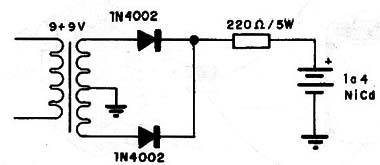Once exhausted, ordinary cells and batteries can not be fully recovered or recharged. There are the types of batteries that can be recharged as the Nicad where we have the statement "rechageable" in the housing. By circulating a current in the opposite direction to normal for a time ranging between 12 and 16 hours these cells can be fully recarregadas.Figure 1 shows a charger circuit for small cells, medium and large NICAD.

This circuit allows up to 6 batteries connected in series to be fully recharged.
However, for ordinary batteries, this circuit can also be used in order to make a "reactivation" of substances that can still provide some energy more and thus prolong its life. We can say that this circuit works as a life extender cells. Thus, once a cell is exhausted you can recover their ability to provide power for some time, leaving them for some time, between half an hour and two hours on this unit. Care must be taken in order to prevent leaks. If a pile shows signs of "leak" or present signs of heating, it must be removed from the reactivation apparatus and recovery and must be thrown away.
The other cells, left in this unit may well operate for several more hours on low power devices such as radios, calculators, watches and other that do not use motors or bulbs. In high consumption appliances such as lanterns and toys, reactivation works, but the time is achieved prolongation of life is much lower




